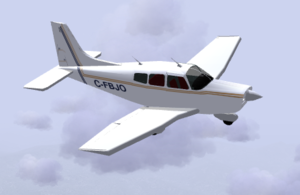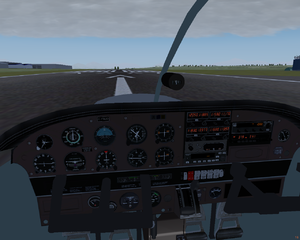Piper Cherokee Warrior II
(Redirected from Pa28-161)
Jump to navigation
Jump to search
 | |
|---|---|
 | |
 Cockpit screenshot | |
| Type | Civil utility aircraft, Light aircraft |
| Configuration | Low wing aircraft |
| Propulsion | Piston aircraft, Single-engine aircraft |
| Manufacturer | Piper |
| Author(s) | David Megginson |
| FDM | YASim |
| --aircraft= | pa28-161 |
| Status | Unknown |
| Development | |
| Website |
|
| Repository |
|
| Download |
|
| License | GPLv2+ |
|
| |
For the newer PA-28, see Piper PA28 Warrior II.
The Piper PA-28 Cherokee is a family of light aircraft designed for flight training, air taxi and personal use, built by Piper Aircraft. In 1978, Piper upgraded the Warrior to 160 horsepower (119 kW) PA-28-161, changing its name to Cherokee Warrior II. This same aircraft, now available with a glass cockpit, is available as the Warrior III, and is marketed as a training aircraft.
Aircraft help
| Key | Function |
|---|---|
| f | fuel tank select |
| ~ | toggle nav lights |
| ! | toggle master battery switch |
| @ | toggle toggle master alternator switch |
| # | toggle fuel pump |
| $ | toggle landing lights |
| % | toggle rotating beacon |
| ^ | toggle anti-collision lights |
| * | toggle pitot heat |
| ( | turn on and/or decrease panel lights |
| 9 | increase and/or turn off panel lights |
| h | toggle carburator heat |
| Ctrl+P | toggle primer pump |
| B | toggle parking brake |
| s | starter |
- All switches and controls (except yoke and pedals) can be operated via "hot-spots".
- Type Ctrl-C to display mouse "hot-spots".
Startup
- fuel on most full main ("f" toggles selector on left side)
- all toggles OFF
- battery master switch to ON ("!" toggles battery master switch)
- alternator master switch to ON ("@" toggles battery master switch)
- electric fuel pump ON ("#" toggles fuel pump switch)
- operate primer pump three times then locked (ctrl-P cycles primer)
- "CLEAR PROP"
- key to start ("s" engages starter)
- pitot heat ON if IFR ("*" toggles pitot heat switch)
- beacon ("%"), nav lights ("~"), strobe lights ("^") ON as required
- landing light if night ("$" toggles landing light switch)
- release parking brake ("B" releases brake)
Takeoff
Takeoff check list on panel.
Normal field
Flaps: Up Throttle: Full open Rotate: 55-60 Kts
Short field
Flaps: 25 degrees (2nd notch) Apply brakes Full Throttle Release brakes Rotate -- 52 Kts Climb Speed -- 52 Kts (Vx) Flaps: Retract after obstacles clear & reaching 79 Kts
Climb
87 Kts Full throttle
Landing
Landing check list on panel.
Normal field
- Fuel Pump: On
- Airspeed: Downwind, 85 Kts; base, 75 Kts; final, 65 Kts
- Flaps: Downwind, 10°; base, 25°; final, 40°
Short Field
- Fuel Pump: On
- Airspeed: Downwind, 75 Kts; base, 65 Kts; final, 63 Kts
- Flaps: Downwind, 10°; base, 25°; final, 40°
- Throttle: Idle after clearing obstacles
- Flaps: Retract immedatialy
- Control Yoke: Hold full aft
Go around
- Pitch: Up
- Throttle: Full open
- Carb Heat: off
- Flaps: retract to 25 degrees
- Airspeed: 63 Kts
- Flaps: retract slowly after clearing obstacles and reaching 79 Kts
- Climb Speed: 79 Kts (Vy)
V Speeds[1]
- Vr: 60 Kts
- Vx: 63 Kts
- Vy: 79 Kts
- Vs1: 50 Kts
- Vso: 44 Kts
- Vg: 73 Kts
- Va: 88-111 Kts
- Vno: 126 Kts
- Vfe: 103 Kts
- Vfinal: 65 Kts
- Vne: 160 Kts
- Max. Crosswind: 17 Kts
General Characteristics
- Crew: one pilot
- Capacity: three passengers
- Length: 23.8 feet (7.3 m)
- Wingspan: 35.0 feet (10.7 m)
- Height: 7.3 feet (2.25 m)
- Empty weight: 1,480 lb (671 kg) for this specific plane
- Maximum gross weight: 2,325 lb (1,055 kg) or *2,440 lb (1,107 kg),* depending on model year and STC
- Useful load: 960 lb (436 kg) for this specific plane
- Full-fuel useful load: 672 lb (305 kg) for this specific plane
- Max takeoff weight: 2,325 lb (1,055 kg) or 2,440 lb (1,107 kg), depending on model year and STC
- Powerplant: 1× Lycoming O-320-D3G Sensenich 74DM6-0-60, 160 hp (119 kW)
- Propeller diameter: 74 inches (1.9 m)
Performance[2]
- Cruise speed (TAS):
- 75% power, 8,000 ft, ROP, wheel fairings installed: 127 knots (146 mph 235 km/h)
- Stall speed (IAS):
- 40° flaps: 44 knots (51 mph, 82 km/h)
- no flaps: 50 knots(58 mph, 93 km/h)
- Range:
- 55% power, 8,000 ft, LOP, no reserve: 695 nm (800 sm, 1,287 km)
- 75% power, 8,000 ft, ROP, no reserve: 580 nm (668 sm, 1,074 km)
- Service ceiling: 14,300 feet (4400 m)
- Rate of climb:
- sea level, 2335 lb: 710 ft/min (3.6 m/s)
Development status/Issues/Todo
Outside:
- propeller is not visible (transparent) when rotating
- (dpm) IRL, I find the propeller effectively transparent to the human eye at cruise RPMs (>= 2100 rpm); a camera will catch it, though
- flaps are moving in steps, they are not fluxional animated
- (dpm) the animation would have to be very fast -- they're not electrical flaps like in the 172, but operated by a manual bar, so a change in flap position would be < 0.25 seconds (as fast as your arm can pull)
- (dpm) the flaps should make a metallic "clunk" noise rather than an electrical "whirr" noise when being changed
- wings and wheels are not textured
3D Cockpit:
- cockpit instruments look flat, they don't have a 3d look
- cockpit is not textured
- no pilot or co pilot present
External links
- Wikipedia
- Piper Warrior checklists (AtlasAviation.com)
References
|
| |||||